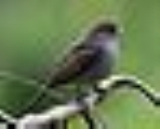
Nilgiri Flycatcher
Encyclopedia
The Nilgiri Flycatcher (Eumyias albicaudatus) is an Old World flycatcher
with a very restricted range in the hills of southern India
. It has a colour similar to that of the Verditer Flycatcher
(due to which it was earlier called the Nilgiri Verditer Flycatcher) which is a winter visitor to the Nilgiris but lacks the dark lores of that species. There are two small white patches at the base of the tail. It is found mainly in the higher altitude of the shola
forests.It has also been classified as a near-threatened species in the IUCN Red list.
and does not have as strong a contrast in the pale face and black lores. The female is duller with dark brown on the upperparts and dark grey below. The two central tail feathers are blue and the lateral feathers are dark brown and edged with indigo with white at the extreme base. This white patch is not easily visible when the bird is sitting. The wing feathers are dark brown with a narrow outer fringe of blue. The juvenile is dark brown with creamy spots and a scaly appearance on the throat and breast. The bill and legs are black and the iris is dark brown.
) while the usual call is a soft nasal chipping eep. They perch upright and produce the chipping note while flicking the tail up and down. The breeding season is from March to June but peak egg-laying is in April. The nest is built in a cavity in an earth bank or a tree hole. They will also use the eaves of houses and wood-work of bridges. The nest is a cup with mosses and lichens on the outside with some feathers and not very well lined. The usual clutch is two to three eggs.
Old World flycatcher
The Old World flycatcher family Muscicapidae is a large family of small passerine birds mostly restricted to the Old World. These are mainly small arboreal insectivores, many of which, as the name implies, take their prey on the wing.-Characteristics:...
with a very restricted range in the hills of southern India
India
India , officially the Republic of India , is a country in South Asia. It is the seventh-largest country by geographical area, the second-most populous country with over 1.2 billion people, and the most populous democracy in the world...
. It has a colour similar to that of the Verditer Flycatcher
Verditer Flycatcher
The Verditer Flycatcher is an Old World flycatcher found in the Indian subcontinent, especially in the Lower Himalaya. It is named after its distinctive shade of copper-sulphate blue and has a dark patch between the eyes and above the bill base. The adult males are intense blue on all areas of the...
(due to which it was earlier called the Nilgiri Verditer Flycatcher) which is a winter visitor to the Nilgiris but lacks the dark lores of that species. There are two small white patches at the base of the tail. It is found mainly in the higher altitude of the shola
Shola
Sholas are patches of stunted evergreen tropical and subtropical moist broadleaf forest found in valleys amid rolling grassland in the higher montane regions of South India. These patches of shola forest are found mainly in the valleys and are usually separated from one another by undulating...
forests.It has also been classified as a near-threatened species in the IUCN Red list.
Identification
This small and somewhat long tailed flycatcher is about 13 centimetres (5.1 in) dark steely blue long bird with a violet-blue forehead with the lores being slightly darker.The male Nilgiri Flycatcher,develops a dark metallic blue colour as it reaches adulthood. It is much darker than the Verditer FlycatcherVerditer Flycatcher
The Verditer Flycatcher is an Old World flycatcher found in the Indian subcontinent, especially in the Lower Himalaya. It is named after its distinctive shade of copper-sulphate blue and has a dark patch between the eyes and above the bill base. The adult males are intense blue on all areas of the...
and does not have as strong a contrast in the pale face and black lores. The female is duller with dark brown on the upperparts and dark grey below. The two central tail feathers are blue and the lateral feathers are dark brown and edged with indigo with white at the extreme base. This white patch is not easily visible when the bird is sitting. The wing feathers are dark brown with a narrow outer fringe of blue. The juvenile is dark brown with creamy spots and a scaly appearance on the throat and breast. The bill and legs are black and the iris is dark brown.
Distribution
This species is found in the higher hills of the Nilgiris, Palnis, Anamalai ranges, the Brahmagiris, Bababudan and Biligirrangan hills.Behaviour and ecology
Like most flycatchers, it makes sallies to capture insects and returns to its perch. It forages mainly in the lower storey but can sometimes be found on top of the canopy. The song is a series of rich warbling notes (having a resemblance to the call of the Pied BushchatPied Bushchat
The Pied Bushchat is a small passerine bird found ranging from West and Central Asia to South and Southeast Asia. About sixteen subspecies are recognized through its wide range with many island forms...
) while the usual call is a soft nasal chipping eep. They perch upright and produce the chipping note while flicking the tail up and down. The breeding season is from March to June but peak egg-laying is in April. The nest is built in a cavity in an earth bank or a tree hole. They will also use the eaves of houses and wood-work of bridges. The nest is a cup with mosses and lichens on the outside with some feathers and not very well lined. The usual clutch is two to three eggs.

